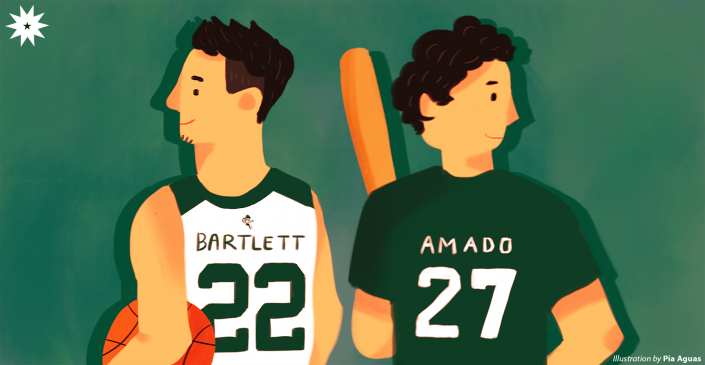Each athlete has their own way of distinguishing themselves on the
playing field. Beyond their distinct way of playing and their presence on the
court, one way for fans to distinguish their favorite player is the jersey
number on
their backs.
Some jersey numbers have achieved a legendary status in their respective sports. From important dates to favorite numbers, there are a multitude of reasons why athletes choose a certain number to represent them—with some holding surprising narratives.
Green Archer Jordan Bartlett and Green Batter Lorenzo Amado pull back the curtains, so to speak, on the personal meaning behind the symbols they wear on their backs.
More than just numbers
To spectators of the sport, sometimes jersey numbers are just numbers. But to the athletes that don these jerseys, these numbers can hold special meanings. For some, these numbers symbolize their inspiration to keep going.
Upon entering La Salle, Amado switched from the number he was known for in high school to 27 in order to honor the passing of his grandfather. The number emblazoned on his back is not just his lolo’s birthday; it is a constant reminder that he plays not just for himself, but also for his grandfather’s legacy. He shares the significance of the number 27, “It helps me remember that although my lolo is gone, he is rooting for me from above. He was definitely my number one fan.” His grandfather’s memory gives him the push he needs to continue forward in baseball. “Rather than simply maintaining a number that people already know me by, my jersey number today serves as a motivation to do my best,” the Green Batter explains.

The number on the back of Amado’s jersey is what gets him through the tough days in the ballpark, as he reveals, “It [reminds me of] why I play, especially during the days that I cannot seem to do well. It is a constant reminder for me to keep my feet on the ground and to know that I am not playing for myself, but for the team and my school.”
Bartlett, on the other hand, wears the number 22 as a reminder of the greatness of his idol Michael Jordan. The number is both a goal and reminder of the greatness he wishes to achieve. He says, “The number always reminds me there is always something harder to work for. Michael Jordan set the standard. There is always someone out there who I can work to reach and surpass.” Bartlett credits his parents, who were loyal fans of the former Chicago Bulls star, for naming him after one of the greatest basketball players: “When I was born in the hospital, my parents were watching Michael Jordan play in the finals. On the spot, they decided to name me ‘Jordan’.”
Up the rafters
Jersey numbers are not exactly unique as some athletes can carry the same number in the same sport. Famous footballer Lionel Messi had to wait his turn to carry the number 10 since former FC Barcelona stars made the most out of bearing the number. After all, the number 10 has become somewhat of a statement in its own right, usually designating a footballer’s position on the pitch as the team’s playmaker, attacking midfielder, or star striker. With many iconic greats having worn the number—from Pele and Diego Maradona to Messi and Wayne Rooney—the symbol may also bear great expectations for younger players now attempting to craft their own narratives and influence their respective squads in a similar, talisman-esque fashion.
Every athlete is eligible to have their jerseys retired, in the same way that they are eligible to be drafted. To be drafted, one must present the skill set that is deemed too fit in the team. But to be immortalized, athletes must exhibit an exemplary performance over the course of their career, a true mark of their impact on the sport. When a jersey number is retired, no other athlete from that team can don the number again. Retiring an athlete’s jersey is a marker of their impact in their sport and it serves as a way of immortalizing their legacy.
In the history of DLSU, there have been only five athletes whose jerseys were immortalized in the rafters of the Enrique M. Razon Sports Center. One of which is the once-in-a-generation volleyball talent Manilla Santos-Ng, who had her number 14 jersey retired back in 2009.
In the NBA, Stephen Curry carries the same number that his father Dell Curry wore over the course of his career. While Curry’s career may not be over yet, if his jersey is retired at the end of his career then it would be an honor for him and his father both. Likewise, Amando’s and Bartlett’s chosen numbers are tributes to those that ignite them. Amando carries the memory of his grandfather every time he steps onto the field. For Bartlett, the 22 on his back pushes him to go above and beyond for the love of the sport.
At the end of the day, it is not the jersey numbers that cement the legacy of an athlete. No number can magically enhance an athlete’s performance in their game. An athlete is not iconic because of their number; it is the athlete who makes the number bear greater significance, not just for themselves, but even for spectators witnessing their careers. Through their passion for their sport, athletes weave moving narratives—the numbers on their backsbecoming not just a symbol, but a statement and story inspiring future cycles of rosters and jersey number selections.
